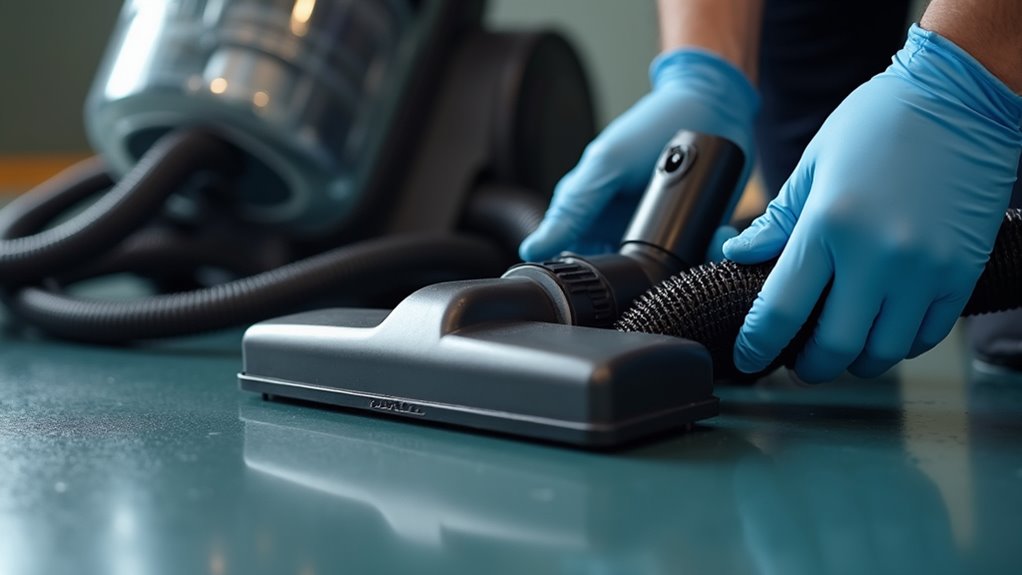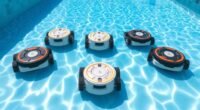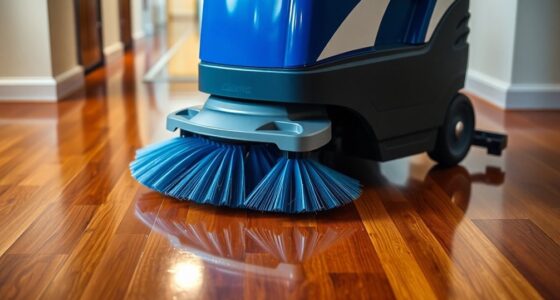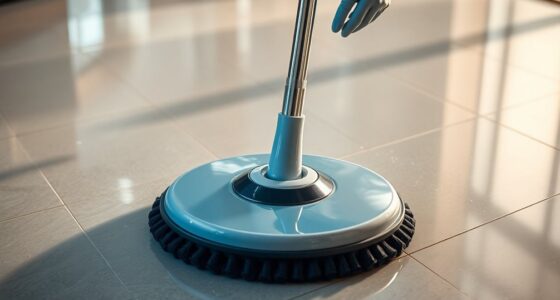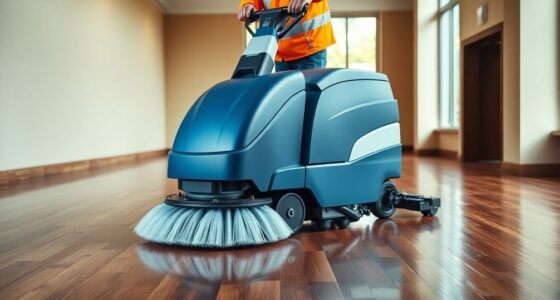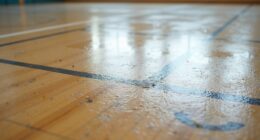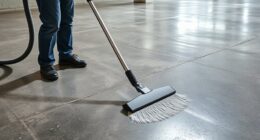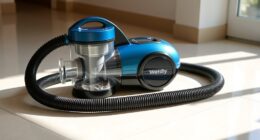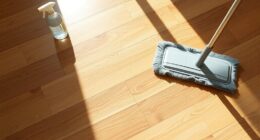If your vacuum isn’t picking up well on rubber gym floors, start by examining the motor for unusual sounds or overheating signs, and check filters to guarantee they’re clean. Inspect the hose for cracks, holes, or blockages, and clear any debris with water or compressed air. Make sure all fittings are tight and settings are correct to prevent surface damage. If you want detailed steps to troubleshoot further, keep going—more tips follow.
Key Takeaways
- Inspect the vacuum motor for unusual noises, overheating, or damage, and clean or replace filters to ensure proper airflow.
- Check the hose for cracks, holes, or obstructions, and clear blockages with water flush or compressed air.
- Tighten hose fittings and replace worn gaskets to ensure a secure connection and optimal suction.
- Verify vacuum settings are appropriate for rubber gym floors to prevent surface damage and maintain pickup efficiency.
- Perform regular maintenance on the motor and hose to prevent debris buildup and ensure effective cleaning performance.
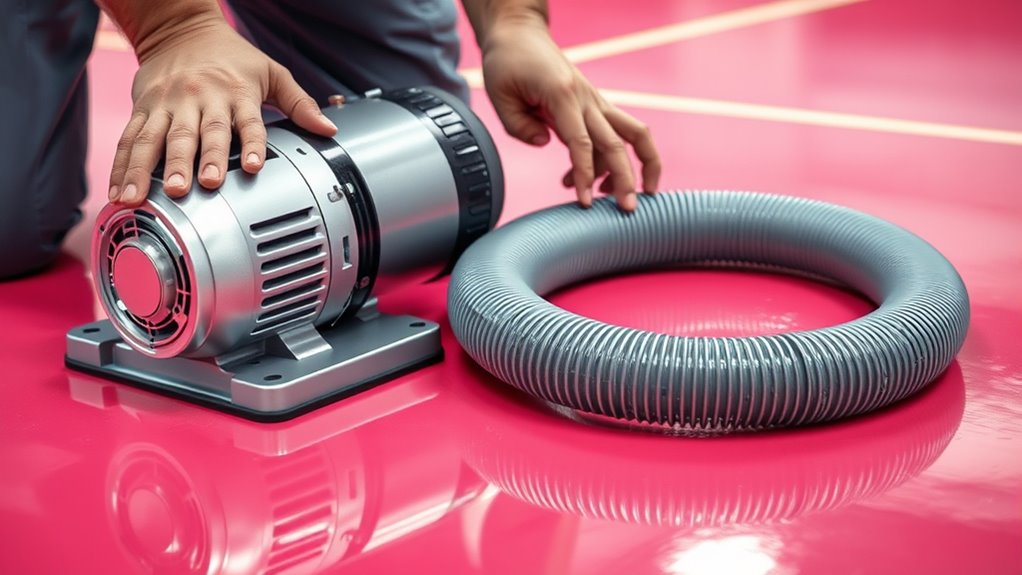
Regularly checking your vacuum motor and hose is essential to maintaining the integrity of rubber gym floors. When you notice your vacuum isn’t picking up debris effectively, it’s time to troubleshoot the motor and hose to identify potential issues. Proper vacuum motor maintenance ensures it runs smoothly, preventing debris buildup that could scratch or damage your flooring. Start by inspecting the vacuum motor for any unusual sounds or overheating, as these can signal motor strain or damage. If the motor appears to be functioning irregularly, consider cleaning or replacing filters, and verify that the motor’s airflow isn’t obstructed. Maintaining the motor in good condition helps prolong its lifespan and guarantees peak cleaning performance, protecting your gym floors from unnecessary wear. Additionally, regular filter replacement is crucial for optimal air quality and motor efficiency.
Next, focus on your hose inspection techniques. A clogged or damaged hose can considerably diminish suction power, leaving debris behind and risking surface damage over time. Begin by disconnecting the hose from the vacuum unit, then visually examine it for cracks, holes, or wear. Use a flashlight to look inside for blockages or debris lodged within, which can restrict airflow. To clear obstructions, try gently flushing the hose with water or using compressed air, but ensure it’s thoroughly dry before reconnecting to prevent mold growth. Regular hose inspections prevent unseen damage from escalating into larger problems, saving you from costly repairs and potential floor damage.
You should also pay attention to the connections between the hose and the vacuum motor. Loose or damaged fittings can cause loss of suction, which leads to ineffective cleaning. Tighten any loose fittings and replace worn-out gaskets or seals promptly. If your vacuum has adjustable settings, verify they are correctly set for your rubber gym floors to avoid overly aggressive suction that might harm the surface. Consistently performing these simple inspections helps you catch small problems early, maintaining the vacuum’s performance and the quality of your flooring.
Frequently Asked Questions
How Often Should Vacuum Motors Be Inspected for Gym Floor Cleaning?
You should inspect your vacuum motors for gym cleaning at least once a month. Regular vacuum maintenance guarantees peak performance, preventing downtime and prolonging the life of your equipment. Check for clogs, wear, or damage to hoses and motors, especially after heavy use or if you notice reduced suction. Consistent inspections help keep your rubber gym floors clean and safe, making your cleaning routine more efficient and effective.
Can a Damaged Hose Cause Vacuum Motor Failure?
Yes, a damaged hose can cause vacuum motor failure. It disrupts airflow, putting extra strain on the motor and potentially leading to overheating or burnout. Regular hose inspection helps catch issues early, preventing costly motor replacement. If you notice persistent loss of suction or motor problems, check the hose thoroughly, replace if damaged, and guarantee your vacuum runs efficiently to protect your equipment and keep your gym floors spotless.
What Are Signs of a Malfunctioning Vacuum Motor?
Did you know that over 60% of vacuum motor failures are due to airflow restrictions? If your vacuum isn’t picking up properly, watch for signs like loss of suction, strange noises, or motor overheating. These issues indicate a malfunctioning vacuum motor. When airflow is restricted or the motor overheats, it can lead to breakdowns, so check filters, hoses, and vents regularly to prevent damage and keep your cleaning efficient.
Are There Specific Hoses Recommended for Rubber Gym Floors?
For rubber gym floors, choose hoses made from durable materials like reinforced rubber or heavy-duty plastic, ensuring they withstand frequent use and rough handling. Look for hoses explicitly labeled as compatible with rubber floors, as they’re designed to prevent damage and maintain peak cleaning performance. Prioritize hoses with good flexibility and durability to avoid cracks or leaks, helping you keep your gym floors clean without worrying about hose failure.
How Can I Troubleshoot if the Vacuum Isn’t Picking up Debris?
If your vacuum isn’t picking up debris, start by checking the vacuum filter for clogs or dirt buildup, and clean or replace it if needed. Inspect the brush for tangled hair or debris and perform brush maintenance to guarantee it spins freely. Also, examine the hose for blockages or cracks. These steps help restore suction, making your vacuum more effective on rubber gym floors.
Conclusion
Think of your vacuum motor and hose as the heartbeat of your cleaning routine. When you check them, you’re not just fixing a machine; you’re ensuring the lifeblood of your gym’s shine flows smoothly. A well-maintained vacuum symbolizes dedication and care, turning everyday chores into a ritual of renewal. Keep these essential parts in top shape, and your rubber gym floors will always stand resilient, reflecting your commitment to cleanliness and excellence.
